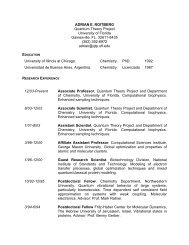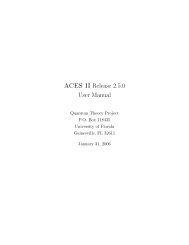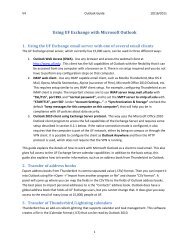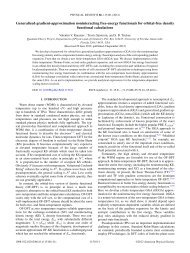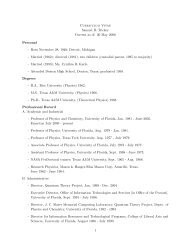ACES II User manual version 2.7.0 (PDF) - Quantum Theory Project
ACES II User manual version 2.7.0 (PDF) - Quantum Theory Project
ACES II User manual version 2.7.0 (PDF) - Quantum Theory Project
Create successful ePaper yourself
Turn your PDF publications into a flip-book with our unique Google optimized e-Paper software.
Cartesian and internal coordinates (and do not allow dihedral angles to be defined). This,of course, does not mean that <strong>ACES</strong> <strong>II</strong> is unable to handle linear molecules such as carbondioxide. Rather, for linear molecules, “dummy atoms” must be used in the Z matrix to avoidproblematic bond angles.To facilitate construction of Z matrices for highly symmetric molecules, certain variablenames have been reserved for specific values.To use these parameters, which are listedbelow, the user must specify a value in the parameter input section, but it need not becorrect since it will be converted to the exact value internally.TDA Specifies the tetrahedral angle, Cos ( ) −1 −13 (i.e., 109.4712. . . ).IHA Specifies the “icosahedral” angle Cos (√ ) −1 15 (i.e., 63.4349. . .).7.1.8 Z matrix analyzerA unique feature of <strong>ACES</strong> <strong>II</strong> is the Z matrix analyzer, which is capable of detectingsubtle and obvious deficiencies in the definition of internal coordinates. This is particularlyimportant for geometry optimizations, in which the construction of the Z matrix and thechoice of parameters to be optimized are of vital importance. The analyzer inspects theinternal coordinates and carries out a number of checks. These include determination ofwhether coordinates given the same name are actually equivalent or coordinates havingdifferent names are equivalent, whether a non-zero gradient is possible with respect to modeswhich are not being optimized, etc. In addition, it determines the number of degrees offreedom within the totally symmetric subspaces of nuclear configurations and compares thisvalue with the number of independent coordinates which are being optimized. If they arenot equal, a warning message is printed out.For most Z matrices with poorly defined internal coordinates, the analyzer prints out anumber of warning messages but does not halt the <strong>ACES</strong> <strong>II</strong> execution sequence. However,for Z matrices which are particularly bad, it will terminate the job. All users are encouragedto carefully inspect the output of the analyzer and to check that the full molecular pointgroup (printed out below the output from the analyzer) is the one intended.If warningmessages are printed or if the symmetry is not what the user expects, then reconstruct asnecessary.A rule of thumb for Z matrix construction is that each internal coordinate included inthe Z matrix must be accompanied by all others which are equivalent to it by the symmetryof the molecule.For example, in water, it is best to specify the molecular geometry bythe two O–H distances and the H–O–H bond angle, rather than by the O–H distance, theH–H distance, and the H–H–O angle. Although most users would definitely use the first Zmatrix, the idea of using just chemical bonds as internuclear distances can be dangerous.33



